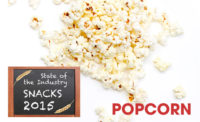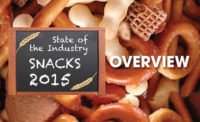The classic pretzel, likely dating back to the Middle Ages, draws its simple inspiration from three basic ingredients: water, flour and salt. Pennsylvania Dutch communities in the U.S. eventually popularized the pretzel and brought to life the hard, crunchy, shelf-stable snack we know today.
Overview | Chips | Puffed/Extruded Snacks | Popcorn | Snack Mixes & Nuts | Tortilla Chips | Pretzels | Frozen Snacks | Crackers
While today’s pretzel market—frozen soft pretzels and hard shelf-stable types—continues those time-honored traditions, new levels of innovation currently seek to capture more market share via new product formats and flavor profiles that range from salty to savory and sweet.
Market data
Despite a strong diversity of new product launches, the pretzels subcategory within salty snacks saw rather flat sales for the 52 weeks ending May 17, 2015, per IRI, Chicago, down 0.99 percent in dollar sales to $1.22 billion. Sales of frozen soft pretzels painted a rosier picture, up 5.56 percent in dollar sales to $77.90 million.
Both segments of pretzels—whether soft and frozen or crunchy and shelf-stable—continue to see relatively strong performance in private label. In salty snacks, private label was up 8.48 percent in dollar sales to $214.61 million for the 52-week period. In frozen pretzels, private label was up 13.94 percent in dollar sales to $5.15 million.
Looking back
Snyder’s-Lance Inc. remains strong at the No. 1 slot in pretzels. And while its traditional Snyder’s of Hanover Pretzels sold well, taking in $434.10 million, dollar share dropped by 1.01 percent.
The most growth came through innovation. The Snyder’s of Hanover 100-Calorie Pack, introduced in 2012 and currently the No. 6 brand in the segment, grew by 17.05 percent in dollar sales to $18.33 million. And the company’s Spoonz pretzels, launched in early 2014, had a strong first year, bringing in $3.67 million for the 52-week period. Its brand-new Poppers line—hollow, light, crunchy pretzel pieces in Original, Cinnamon Sugar and Three Cheese—launched in February 2015, garnered $3.13 million to date.
In the wake of its success with Spoonz in positioning pretzel products to compete with the cracker category, Snyder’s-Lance also released Snyder’s of Hanover Bowties in early 2015, flat, thin, dippable, cracker-like pretzels billed as “better-for-you” in Original, Everything and Parmesan Garlic.
Other recent developments at Snyder’s-Lance include a reformulation of its Snyder’s of Hanover Peanut Butter Pretzel Sandwiches to include honey as the sweetener, and the release of Raspberry Creme Sweet Pretzel Sandwiches just before Valentine’s Day this year.
The company also launched Snack Factory Pretzel Crisps Gluten Free Minis this year, in Original, Salted Caramel and Cheddar, as well as two coated products, Gluten Free Dark Chocolate Flavored Crunch Minis and Gluten Free Vanilla Yogurt Flavored Crunch Minis.
Rold Gold, part of Frito-Lay North America, also added some sweetness to the mix this year with its Cookies & Cream Flavored Pretzel Dippers and Fudge Brownie Flavored Pretzel Dippers, featuring small pretzel rods packaged with indulgent, cookie-inspired dips.
While Utz Quality Foods’ pretzels overall were down 6.93 percent in dollar sales for the 52 weeks ending May 17, 2015, per IRI, its Bachman brand, ranked as the No. 9 brand per IRI, rose 5.84 percent in dollar sales to $15.00 million.
Other products have chipped away at market share, with smaller brands seeing strong dollar share growth. Unique Splits from Unique Pretzel Bakery was up 25.82 percent in dollar share to $5.02 million, with its Unique Pretzels up 13.68 percent to $4.80 million.
Looking forward
Pretzel concepts continue to migrate across categories—from buns and rolls to bagels and even pizza crust. And various shapes have long played a part in shelf-stable crispy pretzel snacks, with thins, cracker-like shapes and pieces among the most-recent additions to the mix.
Soft pretzels are now available in shapes like sticks and nuggets. Foodservice pretzel maker Auntie Annie’s, from Focus Brands, has expanded into the freezer case, offering its Soft Pretzels and Pretzel Nuggets in Classic and Cinnamon Sugar varieties, in addition to sandwich-oriented products.
Frozen soft pretzels can bridge the gap between snack and sandwich through fillings, and J&J Snack Foods leads the pack in such applications via its SuperPretzel and Kim & Scott’s Gourmet Pretzels retail brands, with the latter offering products like Pizza Pretzel, Grilled Cheese and Cheddar Jalapeño.
Frozen soft pretzels could see retail expansion by striving to capture elements of foodservice experiences. “Customization and freshness are two big trends in foodservice poised for retail,” says Dena Strehlow, Ph.D., director, customer innovation and strategy, ADM, Decatur, IL. “This is driven by consumers wanting a different eating experience. For example, some like pretzels with cheese or honey-mustard dip, while others like them paired with chocolate or nut butter. Being able to customize their eating experience is important to consumers, including kids.” She also notes that size could build interest, citing the classic foodservice favorite of a freshly prepared, giant baked pretzel served warm with cheese.
Pretzels also continue to move toward better-for-you positioning. “A lot of the pretzel work that we have done recently has focused on gluten-free, better-for-you and whole-grain formulations,” says Kati Ledbetter, technical sales manager, ADM. “Companies want to use a fiber call-out on their labels. A pretzel is basically carbohydrate-based, so formulators are trying to understand how they can incorporate or increase nutritionals. We are seeing them do this through a variety of ingredients. Fiber and protein tend to be where they are targeting.”
Ledbetter finds that specialty fiber ingredients can add crispness to foods with low moisture and low water activity—an attribute that can help extend shelf life.
It can also help to increase satiety, says Doris Dougherty, technical service representative, Fibersol, ADM. “Evidence indicates that consuming 10 grams of fiber with a meal can enhance satiety,” she explains, suggesting that satiety-building pretzels could be components of ready-to-eat lunch products.
As witnessed in the cracker category, pretzel manufacturers continue to differentiate products via inclusions, like seeds. “The pretzel category has historically carried differentiated benefits from other snacks,” says Strehlow. “Wellness, along with taste and texture, make the category unique. The pretzel is a wonderful carrier of flavor and nutritional ingredients, such as seeds. Whole grain, fiber and protein are benefits consumers are looking for, and there are many opportunities for innovation to consider in this category.”
Combining health with snacking convenience is influencing the pretzel category, says David Woollard, group sales manager, seasoning and spraying, tna, Sydney. “Manufacturers increasingly seek to create snacks that contain less fat, but still fulfill expectations on taste, and are looking for customized equipment that allows flavor flexibility. Oil or fat are key ingredients in most snack and bakery production lines.”
While traditional pretzels are fat-free, varying levels of fat can enter formulas today due to other ingredients in the mix, such as topical applications. “Besides influencing the taste and texture of a product, fat also significantly improves the adhesion of flavors and acts as a binding agent to improve particle cohesion,” says Woollard. “Applying the right amount of oil onto the product is vital to satisfy consumer demand for uniform appearance, taste and texture.”
But the fat declaration on a product label can impact appeal. “For manufacturers, this means the amount of oil needs to be controlled accurately, so the product meets the nutritional value specification on the label,” Woollard continues. “In addition, machines that are able to handle higher concentrations of seasoning powder require less fat and oil to be sprayed onto the products for the seasoning to stick, opening up further possibilities of lower-fat applications and minimal fat declarations.”
Of course, pretzels today are no strangers to indulgence, as well, with flavor profiles that include maple, bacon, Cheddar and caramel surfacing, as well as coatings of chocolate and peanut butter. “There is a growing trend toward ready-to-consume indulgence,” says Woollard. “Consumers seeking to indulge look to exciting flavors and combinations that offer a real treat, with exotic and hot flavors, for example, growing in popularity. Consumer demand for more choice and flavor variety, therefore, further influences the decision-making process.”
This means that snack manufacturers today need equipment that can quickly change between wet and dry applications and are able to run a variety of flavors, capacities, package sizes and materials, notes Woollard. “By choosing a flexible seasoning system, manufacturers can quickly configure their seasoning options to be able to respond rapidly to shifts in consumer demand and preferences.”
Consumers want a consistently flavored product that looks good and tastes fresh, says Woollard. “As such, manufacturers need to select seasoning systems that deliver on these desired elements, while also ensuring that the seasoning is applied effectively and consistently.” He notes that an effective seasoning system can significantly improve production line efficiencies, reducing waste and minimizing downtime.
Some aspects of the pretzel segment have certainly strayed far afield from original water, flour and salt versions.
“For decades, the once-staid pretzel category positioned itself as the baked, more-healthful alternative to other snacks, but that’s all changed,” says Woollard. “Over the past few years, the pretzel market has witnessed significant new product innovation whereby flavor, shape and texture have become key differentiators. While the traditional pretzel form remains popular amongst consumers, chefs and manufacturers are increasingly experimenting to create a unique twist on this ubiquitous staple.”
Expect to see pretzels continue on this adventuresome path. “Whether savory or sweet, popular pairings include sea salt and cracked black pepper, honey mustard and onion, chocolate and peanut butter, and cinnamon and toffee,” says Woollard.
At the same time, select shopper demographics will continue to find appeal in classic, timeless pretzel knots that offer ultra-simple ingredient statements—an easy task for pretzels—with a product appearance aligned with artisan ideals, perhaps via manufacturing processes that can build a certain degree of acceptable irregularity into products.
In order to see new levels of growth as a category, the strong currents of innovation we’re starting to see in pretzels will need to continue.
Overview | Chips | Puffed/Extruded Snacks | Popcorn | Snack Mixes & Nuts | Tortilla Chips | Pretzels | Frozen Snacks | Crackers














